Words: Syed Shiraz Photography: TVS Racing
The TVS Racing Young Racer Media Programme, now in its third edition, was conceived as a platform to train young motorcycle journalists the basics of track riding and to give them an idea as to what it feels like to be a motorcycle racer. TVS Racing devised this fantastic programme three years ago upon taking feedback from motojournalists who wanted more than just a standalone media race (TVS had organized one in 2016). It was concluded that just letting newbies loose on a racetrack doesn’t really add much to their skills, and that proper training was a prerequisite to benefit the most from subsequent trackdays. Thus, a full-on race programme was born.
TVS also say that this programme would make all participants better riders on the road as well, thereby helping them handle all sorts of review units like true professionals. In other words, they meant that the frequency of auto journalists breaking the media units would come down. TVS are doing the whole industry a big favour, then.
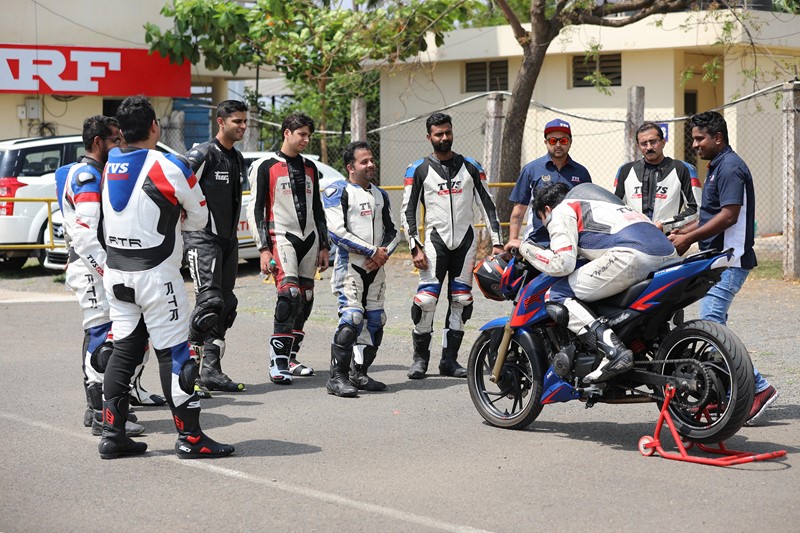
The invite for this programme said that we can send a team member who is less than 30 years old (to do justice to the first word of the Young Media Racer Program). Now, Saad and I are both over 30 years old, and we don’t have anyone younger in the team. However, since I had been hounding the TVS communications team for the past three years to let me participate in this program, I nominated myself, obviously. Last year’s winner was also above 30 so I knew that TVS would accommodate, and they did. Thank you, TVS.

I must add that this programme was essentially designed by TVS Racing for people who have NOT had any formal track training earlier. However, a couple of editors of big media houses sent team members who either live on the racetrack or have had training from DRE, etc., or both, making it an uneven playing field for the rest of us to begin with! And that’s despite having juniors in their teams who have never ridden on a racetrack! Dear editors, please do not let your greed for trophies overpower your work ethics. It’s not healthy for your team’s development too. Give a chance to the new members in your team; that’s what the intent of this programme really is! It will also add a lot to the “work satisfaction” of those employees, and THAT would be a true “win-win” situation; in fact, much bigger than a podium win. Anyway, I hope the TVS comm. team adds a statement on the lines of “nominate a team member who has NOT had any kind of track training yet” to the invites next year onwards.
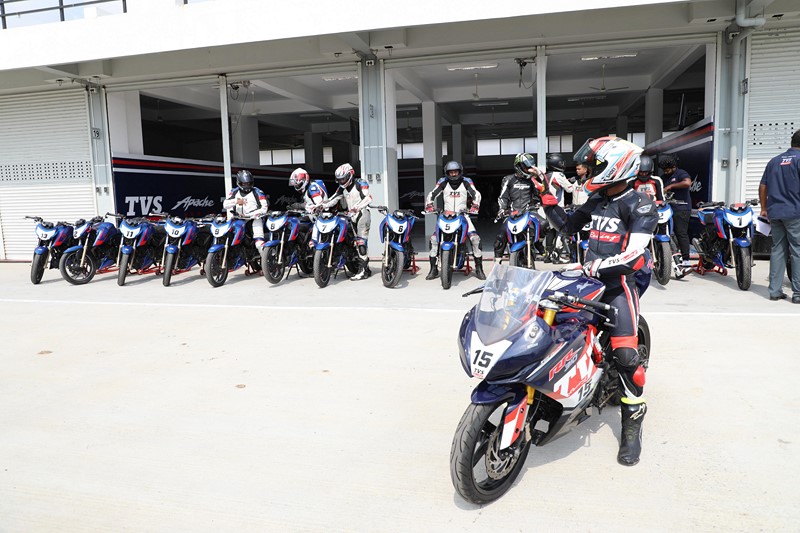
The rest of the pack, including yours truly, comprised people who have never had any track training. The total number of riders was 18, out of which the fastest 15 were to be selected to participate in the three races that will be held alongside the national championship races. I had been praying throughout the flight to at least be able to qualify! There was one more issue though. The Chennai heat.

Coming from a freezing Delhi to an already-sweltering Chennai was the first thing a few of us had to combat. Thankfully, TVS had flown all of us in the night before, and that allowed our bodies to get a bit acclimatized to the sudden change in weather. Also, the name of our resort was Pleasant Stays… I’d crossed my fingers.
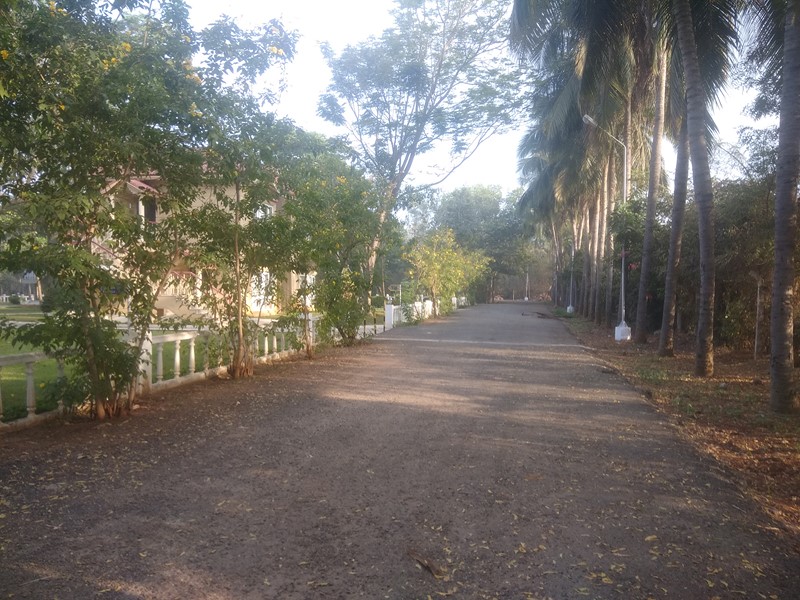
The next day started at 6.30 am for us with a wake-up phone call from the hotel’s front desk. Unlike cellphone alarms, you can’t snooze this one, which is a good thing as eight out of ten times on media events I miss having breakfast for a bit more sleep. This once, breakfast was indeed the most important meal of the day.
We reached the MMRT at around 9 am and were straightaway taken to C1. No, not the first corner of the racetrack, not yet, but a classroom. A quick presentation on TVS Racing’s history and the Young Media Racer Programme by H K Pradeep, DGM, Marketing, TVS Apache (and an 8-time National Motorcross Champion!), and P S Balakrishnan, DGM, TVS Corp. Comm. (& an ex-motoring scribe), TVS Racing Academy’s Harry Sylvester took over. Our training had started now!
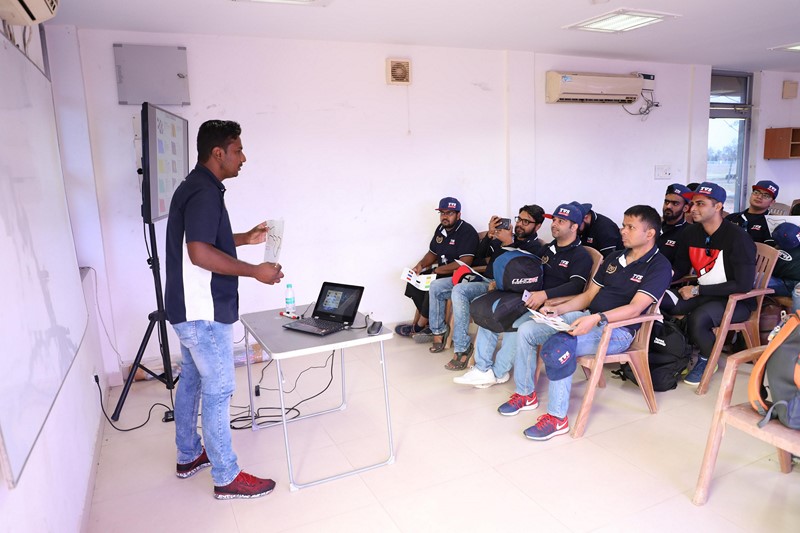
Familiarization with the track and the many flags (yes, there’s more to them than just the green, red, and chequered ones) was accompanied by a few dos & don’ts.

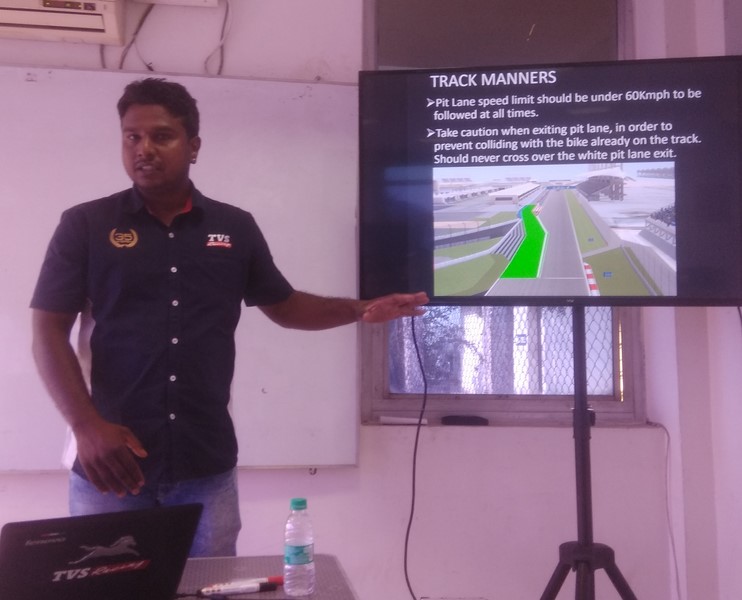
We were also told loud and clear that though we might see ourselves as the Avengers of the motoring world, Race Direction is the actual Thanos here who wouldn’t flinch before humiliating us if we put a foot or wheel wrong.
It was followed by an introduction to TVS Racing’s Level 1 Training Curriculum, which consists of theory and practical sessions on race lines, vision (although the presentation below doesn’t mention it), body posture, braking, and race starts.
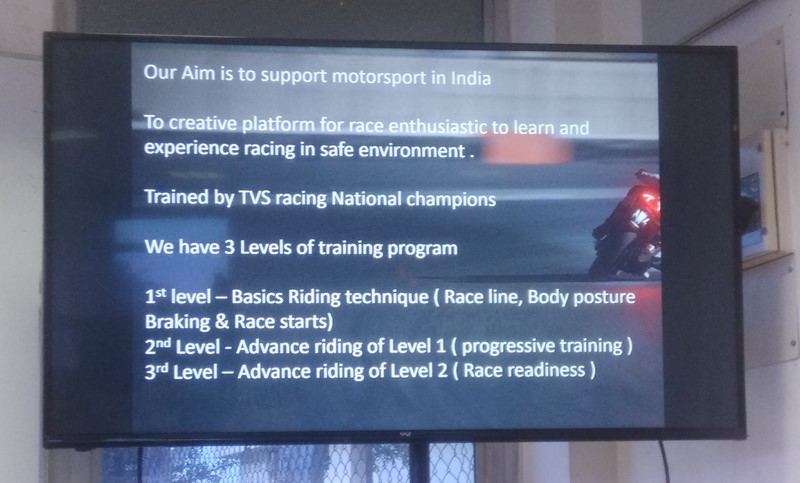
Harry would throw in a bonus later on in the form of “the best gear for every corner”. Now, we were asked to suit up and head for the first drill, which required us to ride the entire length of the track only in 4th gear and with no brakes. Harry did give a disclaimer though that if it comes down to rear-ending someone or avoiding it by braking, then we should be choosing the latter. Thanks, Harry.

The drill was preceded by a slow sighting lap to see where all the marshal posts were at the track. We were divided into two groups headed by our track instructors for the day: TVS Racing’s national champions KY Ahamed and Jagan Kumar. Both were riding their RR Cup 310s whereas we followed them on our racespec RTR 200s (all 2.0 versions that come with a slipper clutch).

Sighting lap over, we came back to the pit lane, and here I must add that entering the pit lane also comes with its own set of rules, the two main ones being signalling by hand (that you’re going back to the pits, so that the rider behind you doesn’t crash into you) and the pit lane speed limit, which is 60 km/h.
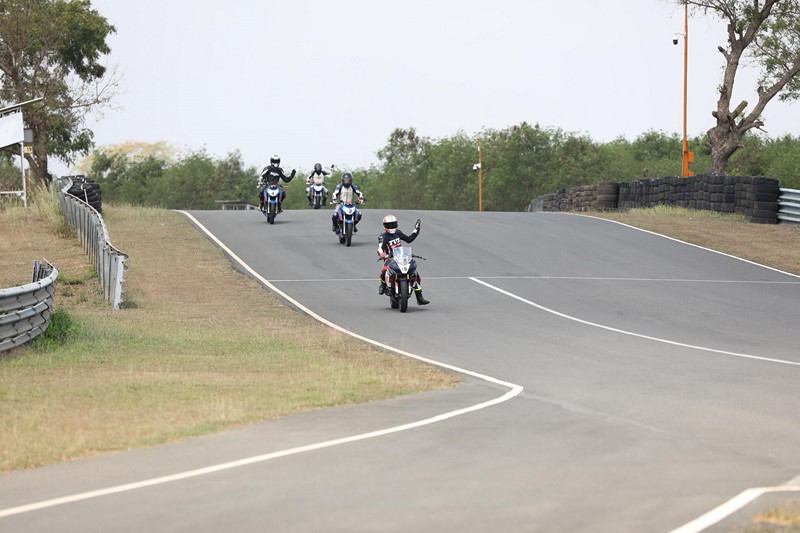
Coming back to the pit lane had us line up again in formation behind our respective leaders, and within less than a minute we were off for the “no-brakes” drill. This was less difficult than I had thought, all thanks to the instructors who had put cross marks to serve as reference points at all corner entries, apexes, and exits! So we just had to follow the instructor ahead, rolling the throttle on and off as required to maintain the gap. As Harry would later tell us, controlling the speed via only the throttle, and not using the brakes, gives you a fine idea of how to ‘feel’ the traction, which is something you can’t do while going flat out in top gear.

After each lap, the one following the instructor would fall back to allow the next person to follow, and this would go on until everyone has had a chance to get directly behind the instructor for a complete lap. The rest of the riders shall continue to commit to the cross marks (reference points) at every entry, apex, and exit to refine their race lines until it becomes second nature.

After a good number of laps, we headed back to the pits, and then to the classroom for a Q&A session followed by the next theory class, which was on braking technique, vision, and choosing the correct gear.

Harry shared the fine art of progressive braking, where you first use the front brake a little to load up the front suspension, and then go progressively harder, again on the front brake, to set your corner entry speed. A couple of riders were in a habit of using the rear brake a lot so Harry urged them to use this opportunity to use the front brake a lot more!
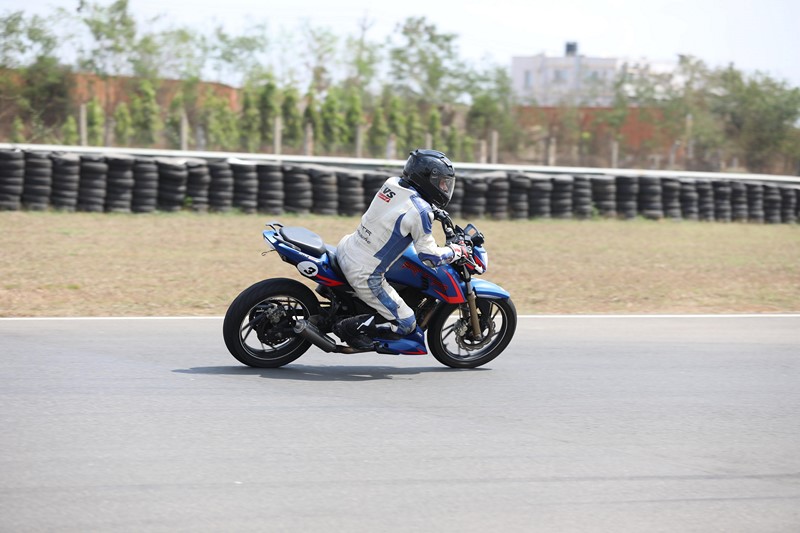
Harry also told us that while he would use the RTR 200’s 4th gear for most corners as his cornering speeds are higher, thanks to his experience on the track, there is no shame in using the 3rd gear until we get there. Choosing the correct gear also makes you have enough torque at hand for a faster exit. Moreover, since dropping down a gear while the bike is leaned over is not a good idea, he reiterated that all braking and gear-changing duties should be completed before tipping the bike into a corner, i.e., while the bike is still upright. Trail-braking is something that’s probably covered in the second or third levels of training, which, sadly, would not be provided to us in this program. But it’s okay as we will do good even if we just master what’s taught to us in Level 1.
Theory over, it was time to go on the track for the second time and practice what we had learned so far.

Harry was right. I could not do justice to the RTR 200’s 4th gear in most corners initially, so I decided that 3rd cog it will be. As I grew more confident lap by lap, I could use the fourth gear in some of the corners.


This drill was also about vision, and Harry had rightly spent quite a bit of time in the theory class to make us understand how to look ahead properly. The importance of vision cannot be stressed enough, and I got a firsthand taste of that as well in this drill. While looking ahead towards the next corner entry automatically got me there, looking at the run-off area once got me exactly there too, i.e., off the track.
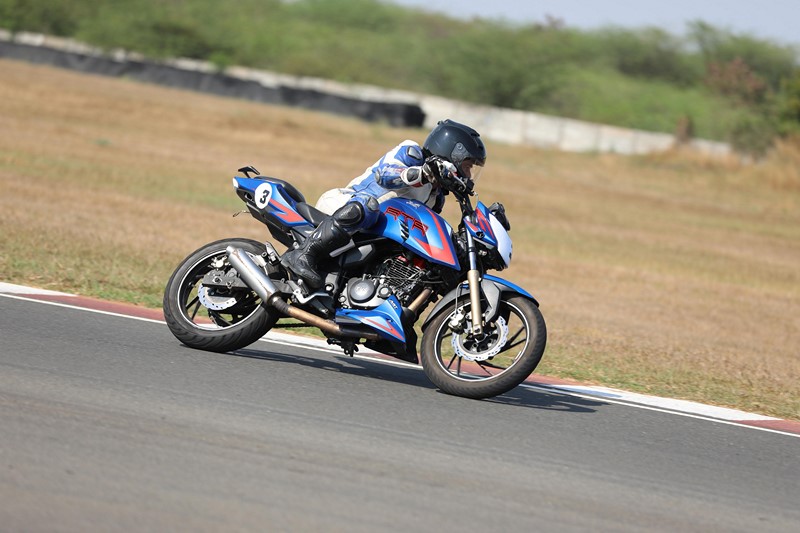
Please note that all other skills would mean nothing if you don’t train your eyes right, unless you’re a chameleon. See, while each eye of the reptile can focus independently, your eyes need the help of your neck and head to point them in the right direction. Therefore, on a racetrack, don’t look at the next corner entry like a shy teenager looking at his crush through the corner of his eye. Instead, aim to have a 360-degree rotating head like an unabashed creep’s that turns endlessly to not leave the sight of woman passing by until she vanishes into the distance.
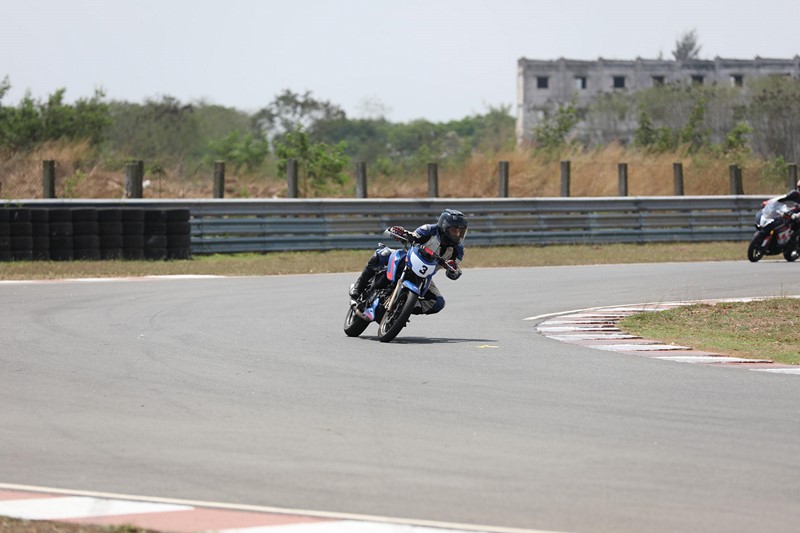
Anyway, it was classroom time once again, and after the obligatory Q&A session, Harry walked us through our next two topics: Body Posture and Race Starts. He was quick to add that first timers should not be expecting to drag a knee this time, and that it would come eventually. He also said that as and when it comes, we should not treat it like a third wheel, and that it’s just an indicator that you’ve achieved the ideal lean angle. He took us outside where a lone RTR 200 was kept, got us to sit on it one by one, and fixed everything that was wrong with our adamant body postures.
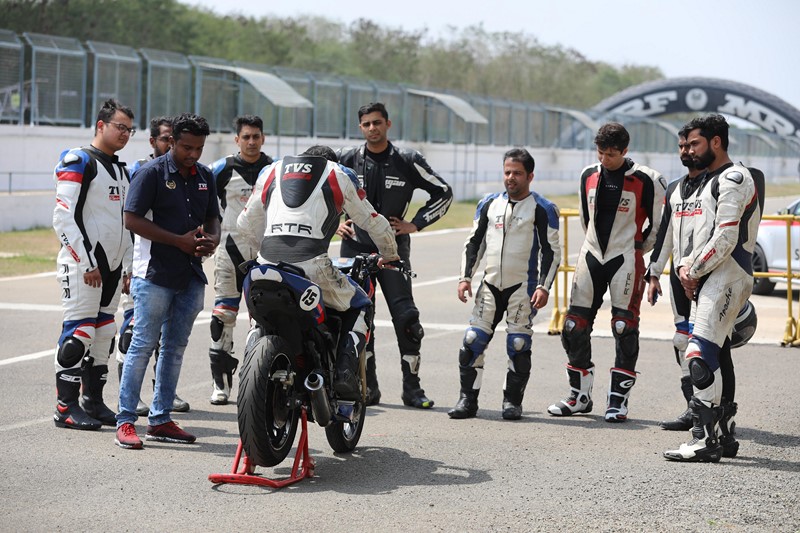
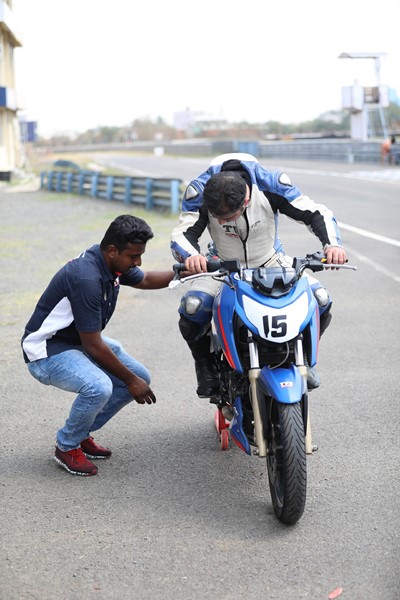
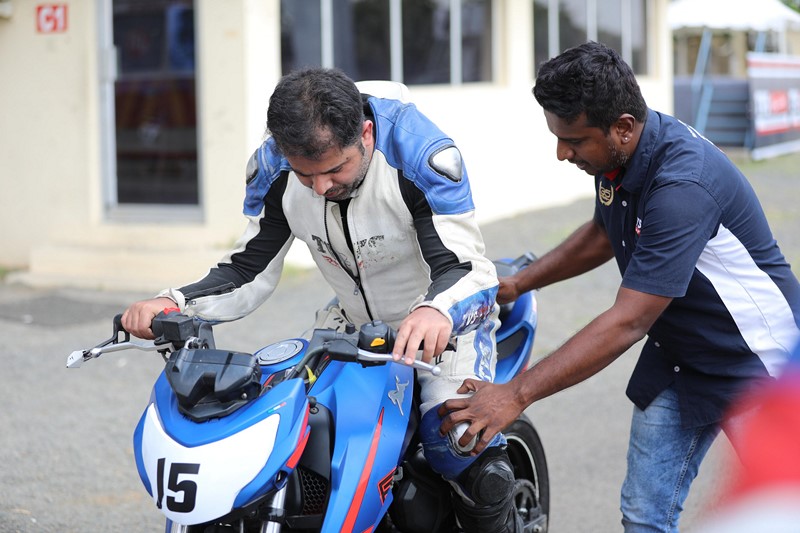
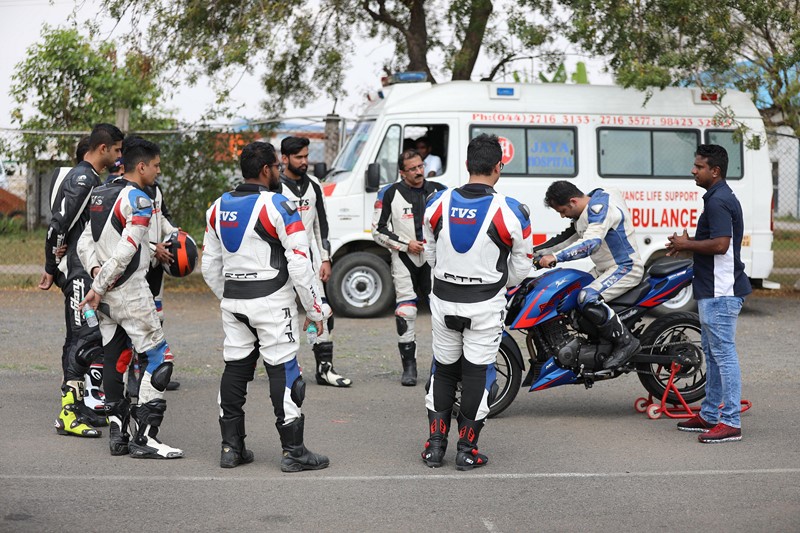
I really would have to work hard to get my body posture right…
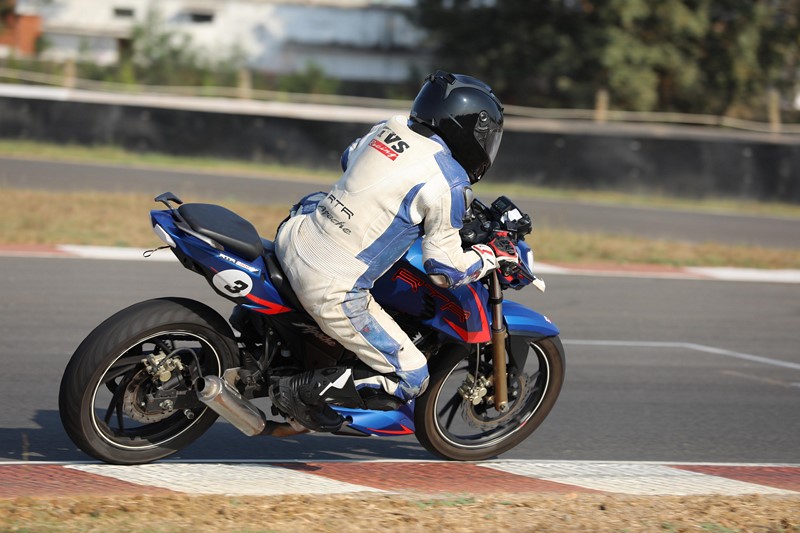
The last session of the day, before free practice and qualifying, comprised something that looks the easiest but turned out to be the most difficult, at least for me! I am talking about Race Starts. Well, all those traffic light GPs that we all have been engaging in for years, and also the 0-100 km/h and 0-200 km/h runs I have been doing so enthusiastically, all of that meant nothing here! We were taken to the Start/Finish line and both Pradeep and Harry explained the procedure to get the best race start.
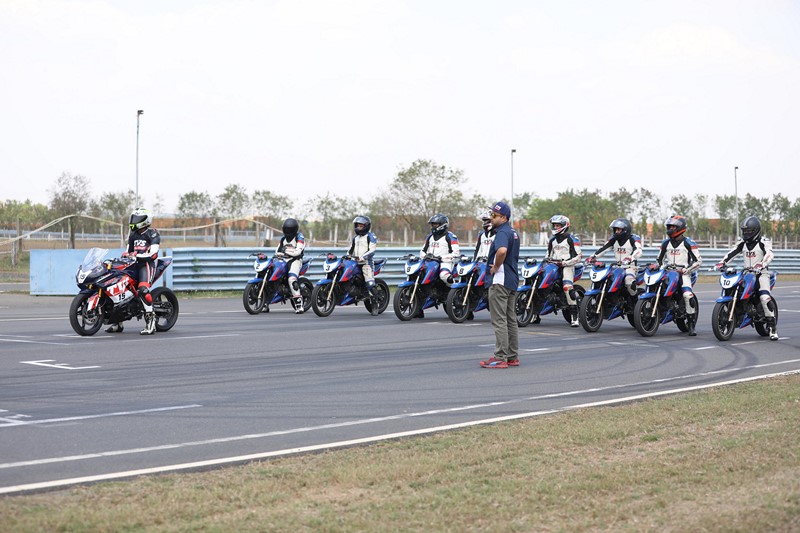
You select the first gear, give a shade less than full throttle, slowly let out the clutch lever and the moment the bike starts to move ahead you press the front brake WITHOUT pulling the clutch lever in. What about the darn clutch plates, I hear you ask. Pradeep anticipated that question and even before any of us could ask, he told us that you do it only when the “five seconds” board is shown. The first two seconds would go in selecting the first gear and finding the clutch engagement point; the next two in holding it there, and the last one would see you go! Ahamed demonstrated that for us, and he was flawless, of course.

It was our turn now. The first couple of riders managed fine but then came the hardest part. Pradeep told us to NOT close the throttle while changing gears! Now, over the time, in any scenario that requires us to go fast, we all have programmed our brains to go clutchless. And clutchless upshifts do not happen without closing the throttle momentarily, but according to Pradeep that ain’t the quickest way on a track! He asked us to lock the throttle at full revs and shift gears using the clutch. When my turn came, the bike wheelied off the line, I backed off to bring the front wheel back, and then forgot the “don’t close the throttle” part. Simply put, I botched up. So along with working on my body posture, like I had mentioned above, I’ll have to get my race starts right as well.

Training was finally over and it was lunch time, post which free practice would see us sewing it all together, which would be followed by qualifying laps and results. I must confess that I have never been much of an eater, but this lunch takes the distinction of being my smallest meal ever. The food was good though. It’s just that you shouldn’t gorge before indulging in any frenetic activity.
Soon enough, all 18 of us were put on the track for about ten minutes of free practice. I took it easy on the first lap to memorize the track again, and upped the pace from second lap onwards. The red flag was out by the fourth lap and we headed back to the pits. The pit-crew hurriedly got on to the task of fixing transponders on our bikes, and Ahamed quickly tested if all of those were working properly. The first five riders were now summoned to head for the qualifying laps. Riding bike no. 3, I was in the first batch. We were required to do four laps, out of which the first would be a sighting lap, while the rest three would be timed, and the best of three would determine where you stand in qualifying.
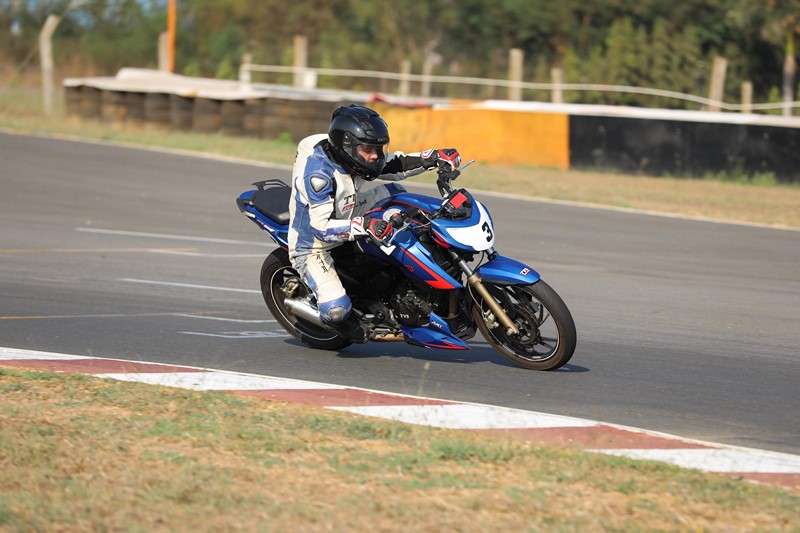
Like I had mentioned earlier, I had come to Chennai with an aim to just qualify, and would have been okay with a 14th or even 15th place. I must also let you all know that I am the oldest rider in the group! How old? Well, I am about five years older than the next oldest guy in this programme, and I am also about 15 years older than the youngest lad. Yes, I saw the dinosaurs die. I am that old. So imagine my happiness when I got to know that I had qualified in 7th place in such young company! My best lap was 2.32.03. Let me share all the qualifying lap times and positions below:
Position & Lap Times
(1) 2.25.80
(2) 2.26.14
(3) 2.28.32
(4) 2.29.38
(5) 2.31.62
(6) 2.31.93
(7) 2.32.03
(8) 2.33.68
(9) 2.34.88
(10) 2.42.32
(11) 2.43.96
(12) 2.44.57
(13) 2.48.50
(14) 2.53.43
(15) 2.54.59
(16) 3.14.20
(17) 3.18.89
(18) 3.39.40
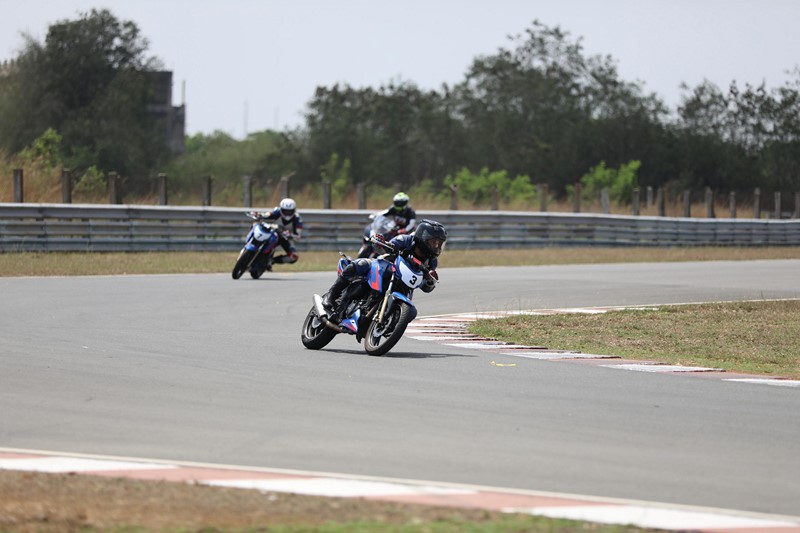
I was glad to see that half a day of training by TVS Racing had brought a track novice like me closer to the lap times of track regulars! As you can see above, number 8 and 9 were also not far off. However, the difference kept on increasing from number 10 onwards. The three people (nos. 16, 17, & 18) who could not qualify will enter a race each as a wild card. As you can see, it was a good day for all.
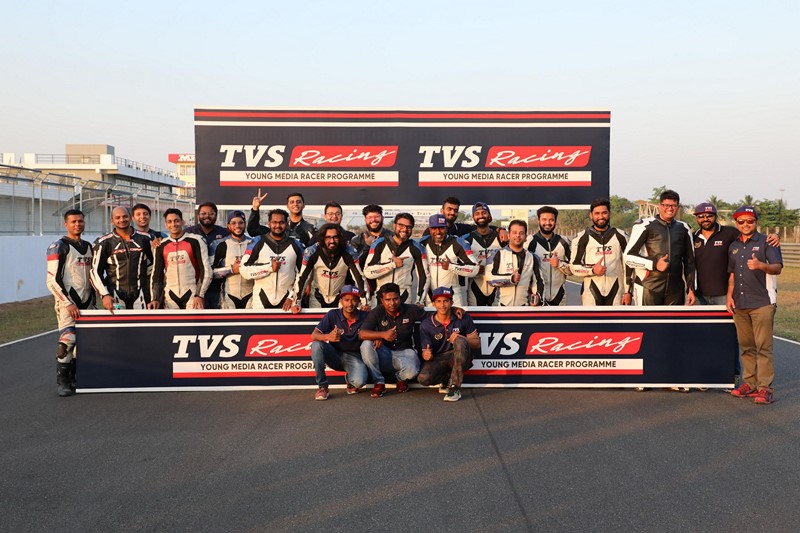
If you’re also interested in TVS Racing’s Level 1 training, then you’re in luck as TVS would be taking a batch this month on the 30th at MMRT. If you somehow miss this one, then don’t fret as they would be organizing it a lot more frequently than most other track schools. Level 1 training from TVS Racing will cost you INR 7,000 if you own an Apache, and INR 10,000 if you don’t. The fee includes Level 1 training, riding gear, breakfast, and lunch. You just have to carry a double-D ring DOT/ECE certified helmet and compression tights (to be worn inside the race suit). Of course, you will also get a TVS Racing Training School Level 1 completion certificate. I got one too.
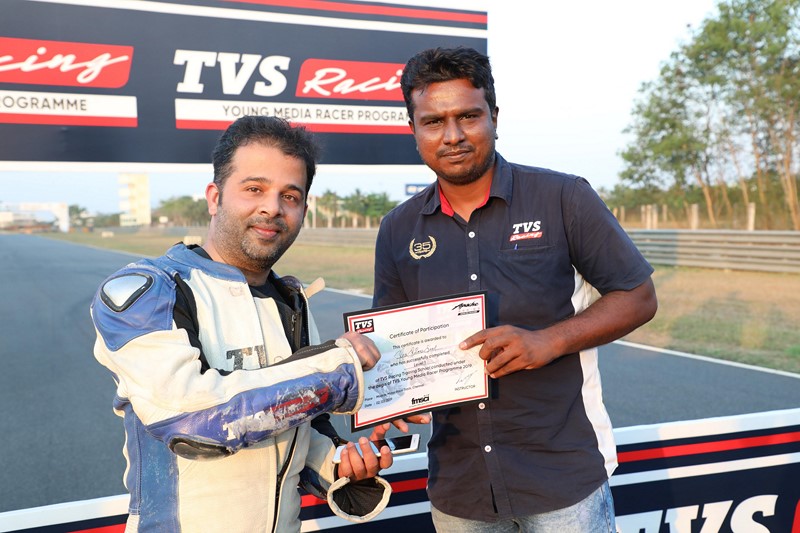
Now please wish me luck for the upcoming races. The goal is to move one position up in every race. It’s not easy, but I shall give it more than my best.


